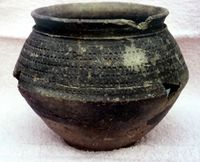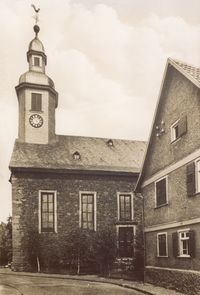Local history of Okriftel

Many archaeological finds from the Neolithic period prove that the Okriftel district, located at the mouth of the Schwarzbach into the Main, was already a preferred settlement area about 6,000 years ago. Both rivers have been used as natural transportation routes for a very long time, and their abundance of fish has been treasured as a welcome source of food. There have been numerous finds from the Bronze and Iron Ages as well as the discovery of a ‘villa rustica’ (farm) from Roman times and the Merovingian cemetery (500 AD), which was found during construction work in 1954, demonstrating that the area has always been inhabited.
First mention 1103
It is assumed that the village was first created on the fluvial terraces of the Main in the 3rd/4th century. Okriftel is mentioned in writing for the first time in a deed of donation from 1103. Walpurga from ‘Acruftele’ had her own property, consisting of two mills, a ship and country estates, transferred to the St. Jacob’s monastery in Mainz. The church in Okriftel, which was mentioned in a document in 1184, was also the mother church of Hattersheim until 1313. However, even after the separation of the churches, Hattersheim had a tithing obligation to the Okriftel church. In 1595, the Hattersheim community was finally released.

The Okriftel coat of arms

The Okriftel coat of arms represents a silver oak tree with golden acorns on a black background. This coat of arms has been used since 1938, although it was created as a result of a misunderstanding. The court seal of 1712, which served as a model for the coat of arms, had a monogram with all the letters of the town's name. This became an oak tree, whether intentionally or unintentionally. And because the thousand-year-old oak in Okriftel was once a showpiece of the village, the people of Okriftel got their way and achieved official recognition for this coat of arms in 1938. The colours black and silver were selected to document centuries of allegiance to the Counts of Isenburg-Büdingen
[Source: R. A. Bölts, Geschichten zur Geschichte]
Isenburg Dominion

A drastic change for Okriftel was the assumption of jurisdiction by the Counts of Isenburg in 1478; in 1560 they also took over the sovereignty. The villagers had to accept the Lutheran faith of their sovereigns in 1545 and the Calvinist faith in 1596. Until the mid-20th century, Okriftel remained predominantly Protestant. This differentiated it from Hattersheim. There, the inhabitants had already returned to the Catholic faith soon after the Reformation movement at the beginning of the 17th century. In 1817, the Reformed and Lutheran denominations had united in Nassau. In 1809, a new church in the classical style was built in the Alte Mainstraße on the initiative of the member of the Frankfurt French Reformed Church, Jacob Du Fay. It replaced the modest predecessor building in the old churchyard where the memorial now stands. In 1984, it was named Matthäuskirche.
Main Ferry
The domain of the Counts of Isenburg lay south of the river Main. In order for the Isenburgers to be able to reach their only property, which was located on the other side of the Main, the village of Okriftel, they had to create well-functioning boat links. But for the people of Okriftel, the ferry crossings were also very important from a social and economic perspective, as contact with the Catholic, Electoral Mainz neighbouring villages was very limited. From 1716 onwards, there is evidence of a regular ferry service.

Emblem
The oak tree is the traditional emblem of Okriftel. Until 1929, an oak tree which was about 500 years old had marked the entrance to the old town centre – where Dalles is today. However, the local coat of arms with the oak tree was only awarded to the municipality in 1938.

Gründerzeit (Founders Period*)

Until the 19th century, Okriftel was an agricultural community, apart from small craft businesses. At the mouth of the Schwarzbach – which was still known as Goldbach at that time, there was a mill called the Bonnemühle, from 1697 onward. The industrial age also arrived in Okriftel in 1873 with the establishment of a grease factory by Moses Haas and a soap factory by Marius Lang. However, the foundation of the cellulose factory on the banks of the Main in 1885 strongly characterised the place. The location was well-selected, as the enormous quantities of wood which were used for production could be brought in cheaply by rafts and later by barges. As early as 1886, Philip Offenheimer took over the factory, and consistently increased production. Around the turn of the century, paper production was introduced, and after the First World War, petrol production. In 1910, the factory already employed 226 employers and employees. Philipp Offenheimer was considered a patron of the community. He supported the construction of the first Okriftel town hall in 1930, which was equipped with an apartment for the mayor, public baths and a nurses' station. He had made a building on his company premises available to the small Jewish community as a school and prayer room. In 1930, his son Ernst Offenheimer took over the company after the death of his father. In 1933, he had to emigrate to the United States of America due to the rising pogroms of the National Socialists. After the Second World War, Phrix AG of Hamburg acquired the company and expanded it further. By 1961, a good 1,000 people worked in this industrial operation. Ten years later, the end of the tradition-rich industry of paper production came for Okriftel.
*Gründerzeit: The years of rapid industrial and economical expansion in Germany at the end of the 19th century
Okriftel district
After the Second World War, Okriftel became a residential area for workers. Social housing, new kindergarten buildings, schools and sports facilities changed the image of the village. In 1972, Okriftel, Eddersheim and Hattersheim combined to become a new town, Hattersheim am Main. In the late 1970s and 1980s, the district of Okriftel developed into a constantly growing, popular residential area.
Further information on the history of the districts of Hattersheim and Okriftel can be found in the commemorative publications issued on the occasion of the town anniversaries of 875 years of Hattersheim and 900 years of Okriftel. You can purchase a copy at the ‘Stadtpunkt’ - Citizens' Information Office for 10 euros.







